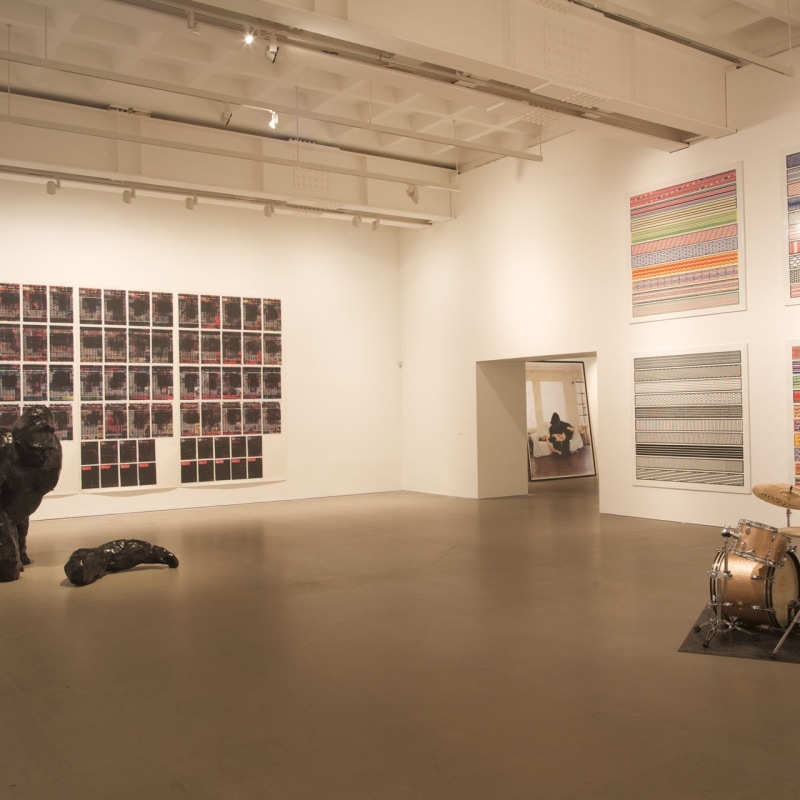Arnolfini is proud to present the first major retrospective of artist Angus Fairhurst (1966- 2008).
One of the most influential members of the group of artists associated with London‟s Goldsmiths College in the late 1980s, Fairhurst participated in the seminal exhibition, Freeze, in 1988, which introduced the world to a generation who became known as the Young British Artists, setting the tone for contemporary art in the UK over the next two decades. This exhibition will feature examples from across his full body of work, which defied categorisation through its sheer breadth of media and invention: painting, performance, animation, photography, video, sculpture, music, print, wallpaper, drawing, collage. Touching on subjects as varied as the nature of the self, desire, sex and death, the emptiness of expression, and the ubiquity and power of advertising, but always under-cut with a particular sense of the absurd.
In contrast to the brash shock tactics of many of his contemporaries, Angus Fairhurst was an artist whose work was always a subtle combination of conceptual rigour and formal aesthetic concerns, interrogated with an irreverent, self-parodying wit. Over twenty years, he re-visited and re-worked different strands of ideas, such as perhaps Fairhurst‟s best known „gorilla‟ series of works, included in this exhibition. Gorillas populate his early cartoon drawings such as male figure with ape, incorporating man and beast in unlikely, sometimes comic, sometimes melancholic, pratfalls. The character of his gorillas were in many ways similar to the artist persona of Fairhurst himself, who played up a combination of clown and fall guy. In the large bronze gorillas, such as A couple of differences between thinking and feeling the distinct lack of pomposity, combined with a hitherto unseen level of scale and gravitas, makes for a particularly timely relation between the unreal, the abject, and the monumental.
“I wanted to make a classical sculpture which has the lightness of a cartoon… A solid object cannot look like it might just disappear if you stopped thinking about it but a cartoon seems light enough that it might just do that.” Angus Fairhurst 2002
Throughout his practice, Fairhurst made collage the very beginning and ultimate end of his work. Using it to expose depths of negative and positive space, it is there from the very early drilled, punched photographs and postcard images. The relationship between the world and photography, print, image and text is so integrated, so embedded, that in a way all his art-making is directly or indirectly a form of collage.
Later pieces such as A Magazine - Everything removed except 1cm border 2005 and Ten Pages from a magazine, body and text removed, 2006 and Five Billboards, body and text removed, 2004 is a reminder of how very different methods of communication can be: bright, crass, shiny, reflective, not one-to-one or lost in contemplation. There is no story, no true account, just fashion, with its baggage, here.
The Low, Lower and Lowest Expectations paintings (1996-7), made by sign writers at Fairhurst‟s request, show how meaning can live purely on the surface. The series of works is caught within a deliberately ambiguous role for painting, collage, and picture. A doodle based on the human genome has been put into a computer to produce a series of patterns painted in green, red and blue, yellow, black and white, which are overlayed until the image becomes illegible.
While not as systematic as these computer generated paintings, the series of Underdone/Overdone paintings (1998) accumulate layers until the image is erased. Depicting a primeval forest, each is a hallucinogenic view of rows of trees built up by and through repeated layers of colour separation, the repeated layers of colour build until any possibility of interpretation is almost completely crowded out. The pictorial structure of nature remains underneath however. This strong sense of love and an understating of natural form is important and evident in all Fairhurst‟s work. The Underdone / Overdone paintings were originally presented as a frieze in the gallery, with a drummer employed to play a random, unscored tattoo for an hour each day. This will be repeated here at Arnolfini.
With associations to the work of Samuel Beckett, Fairhurst‟s use of the loop becomes a metaphor for the absurdity of life itself: we are born, we wake up, we go to sleep and inevitably we die. Fixed conclusions are eschewed in favour of an unresolved, constructive chaos. Often his method was to select the parameters of an accumulative system and then abandon it, allowing the work to determine its own outcome. It is only when disintegration rendered the original starting point unrecognizable that something new began to emerge. “Its like saying a word over and over again until it loses its meaning, and then gets it back again” Angus Fairhurst 2007.
Editors Notes:
The exhibition is curated by Tom Trevor, Director of Arnolfini, who previously worked with Fairhurst on three occasions, including his only one-person exhibition in a public-funded space in the UK. The exhibition is presented in collaboration with Sadie Coles HQ and the estate of the artist. A fully illustrated book, with texts by Sir Nicholas Serota, Sacha Craddock and James Cahill, published by Philip Wilson Publishers, will accompany the exhibition. Following its launch at Arnolfini the exhibition will go on to tour internationally until 2011.
Angus Fairhurst exhibitions; Following Freeze (1988), Fairhurst exhibited in most of the landmark group exhibitions of his generation, including Brilliant at the Walker Art Centre in Minneapolis (1995), Some Went Mad Some Ran Away at the Serpentine (1994), Apocalypse at the Royal Academy (2000), and In-a-Gadda-da-Vida, with Sarah Lucas and Damien Hirst, at Tate Britain (2004). He also had a number of significant one-person exhibitions, notably at Sadie Coles HQ (London), Spacex (Exeter) and at galleries in New York, Berlin, Sao Paulo, Vienna and Amsterdam.
For further information please contact the gallery at +44 (0)20 7493 8611 or press@sadiecoles.com
